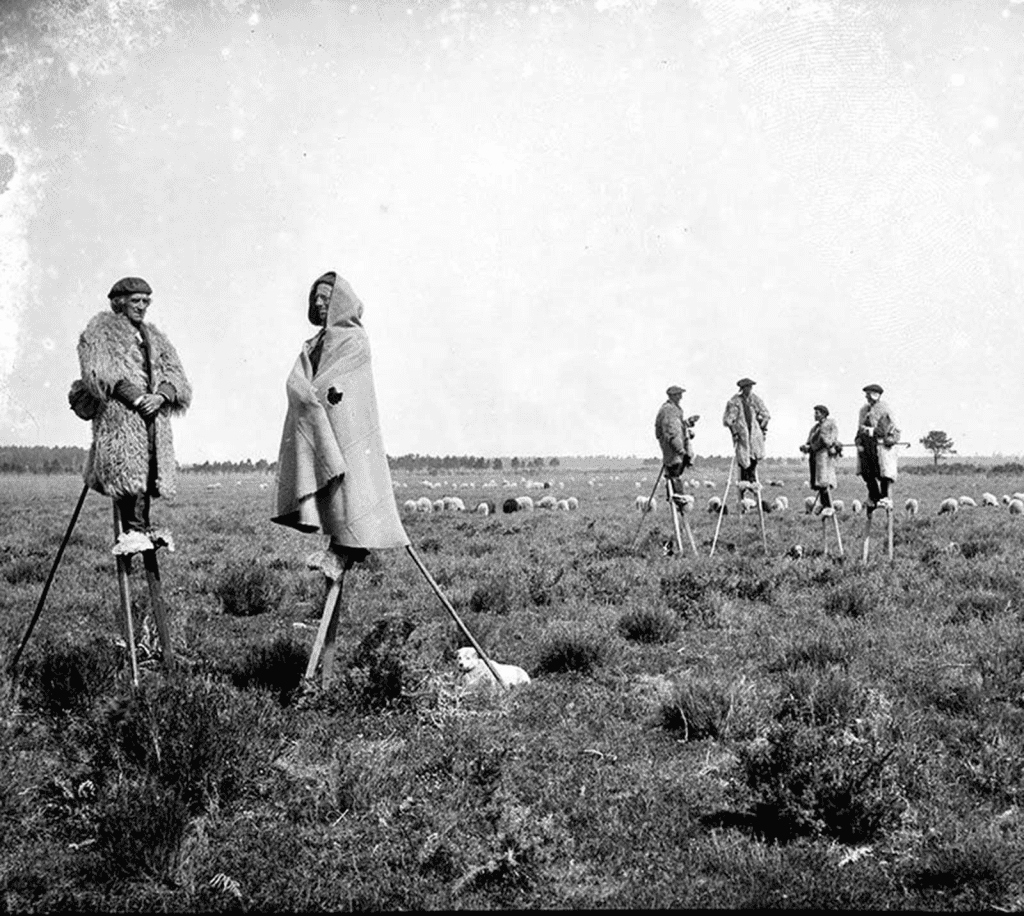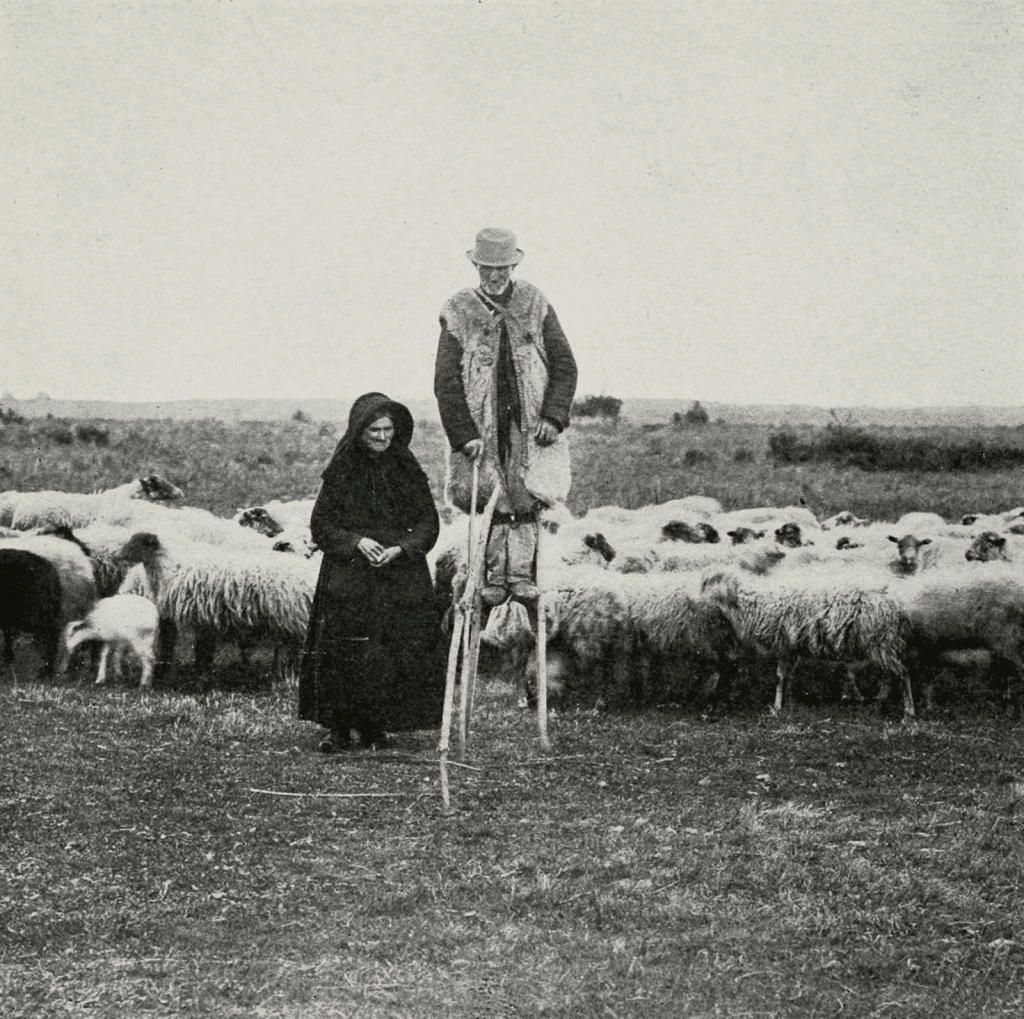Walking Tall in Southwest France
In the windswept plains of southwest France during the 19th century, a unique tradition emerged that would defy both gravity and expectation. Landes shepherds, tending to their flocks across vast marshy terrain, took to the skies well, almost. They didn’t fly, but they did stand atop 15-foot stilts, mastering the art of walking above the landscape that challenged every step on foot.

This wasn’t for show or spectacle. It was a practical and brilliant response to an environment that was hard to tame. These shepherds, dressed in thick woolen coats known as “prisses” and armed with a wooden staff, became a part of the landscape towering, watchful figures gliding across the boggy fields of Gascony.
Why Stilts? The Terrain Made the Rules
The Landes region, before it was reforested in the 20th century, was a desolate, swampy flatland. The soil was sandy, and the ground was often too wet and unstable to traverse easily. Shepherds faced the constant challenge of moving across these marshes without sinking or getting stuck. So they adapted. Their solution? Wooden stilts, sometimes reaching heights of 15 feet.
Video: Walking shepherds of France’s grasslands #rarehistoricalphotos
These towering poles allowed them to stay dry, move swiftly across soggy ground, and keep an eye on their sheep from an elevated perspective. From that height, they could spot predators, guide their flocks, and even communicate with fellow shepherds across great distances using hand signals or calls.
Balancing Act and Break Time
It wasn’t just about walking. Landes shepherds developed a whole lifestyle around their stilts. Using their staff, they could form a tripod when they wanted to rest. This meant they could sit midair, balanced above the wet earth, eating a meal or simply watching their sheep graze.
The practice required skill and strength, passed down from one generation to the next. Children in shepherd families would learn how to walk on stilts at a young age, turning what seemed impossible to outsiders into a daily routine.

More Than Shepherding: Community and Culture
As the tradition grew, stilt-walking spread beyond shepherds. Villagers began using stilts for everyday tasks, even attending church or visiting markets without ever touching the muddy ground. Stories tell of stilt races and performances at festivals, where shepherds would dance, leap, and run on their towering poles astonishing travelers and inspiring admiration.
Eventually, the sight of stilt-walking shepherds became synonymous with the region itself. Tourists and artists were fascinated by the imagery: tall, woolen figures gracefully navigating an unforgiving land. It was a symbol of creativity, adaptability, and the quiet heroism of rural life.
Video: The stilt-walking shepherds of France’s grasslands, 1843-1937
The Decline and Rebirth of a Tradition
By the late 19th century, the French government began large-scale reforestation of the Landes region, replacing the marshes with pine forests. With the ground becoming more stable and accessible, the need for stilts slowly faded. Modern footwear and infrastructure made the towering poles obsolete for most practical purposes.
Yet the legacy didn’t vanish. Today, in towns across Landes, stilt-walking lives on through cultural festivals and historical reenactments. Performers and historians keep the tradition alive, not just as entertainment but as a tribute to the ingenuity of those who came before.

Lessons for Today: Innovation from the Ground Up
The story of the Landes shepherds is more than a quirky footnote in history. It is a powerful example of how communities adapt to their environment with creativity and resilience. Faced with difficult conditions, these shepherds found a way not just to survive but to thrive.
Their approach to problem-solving continues to inspire conservationists and environmental thinkers. In an era when humans are constantly seeking balance with nature, the story of the stilt-walkers reminds us that sometimes the best solutions don’t come from changing the landscape but from rising above it.

Conclusion: Walking Tall with Purpose
The image of a lone shepherd, perched high above the marshes on wooden stilts, speaks volumes about human determination. With a simple tool, they overcame nature’s obstacles and shaped a lifestyle that still resonates with admiration today. The stilt-walkers of Landes weren’t just shepherds they were innovators, stewards of the land, and quiet icons of rural strength.
In remembering them, we honor not just their height but their heart.


